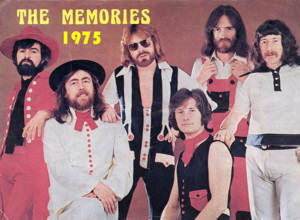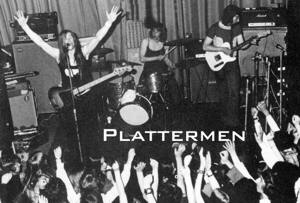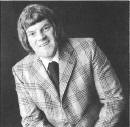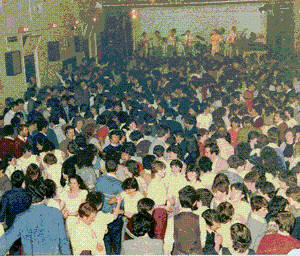The "Transition" Years
By Gerry Gallagher © 10/27/2004
 I
wish I could coin a catchy name for that period in Irish music which stretched
from roughly the early 1970’s until the late 1980’s. The time "in between" the
demise of the 60's showbands and Ireland's explosion onto the International
music scene in the late 80's and early 90's. A lot of articles and books have
been published about those hallowed years of the showband era. But whenever I
read that the “era” was over by the early 1970’s, I want to add, “yes, but the
ballroom scene wasn't exactly dead, at least not yet!” As a musician who only
started out in 1974, I certainly didn’t think the scene was gone, nor did a lot
of other bands, or promoters! I
wish I could coin a catchy name for that period in Irish music which stretched
from roughly the early 1970’s until the late 1980’s. The time "in between" the
demise of the 60's showbands and Ireland's explosion onto the International
music scene in the late 80's and early 90's. A lot of articles and books have
been published about those hallowed years of the showband era. But whenever I
read that the “era” was over by the early 1970’s, I want to add, “yes, but the
ballroom scene wasn't exactly dead, at least not yet!” As a musician who only
started out in 1974, I certainly didn’t think the scene was gone, nor did a lot
of other bands, or promoters!
The early seventies were an interesting time for the Irish
music scene. The original showbands were definitely a dying breed. A few of the
big names gave up the ballrooms and focused on cabaret for a while. More often
though, showbands simply morphed into either pop or country bands. Names like
the Miami, Sands, and Nevada on the pop side; and the Mainliners, Mighty Avons,
and Indians on the country side, kept going with different lineups or by
swapping lead singers. They still did well, many continuing to trade on the
popularity they had earned during the heady days of the showbands in the 1960’s.
 However,
the “death” of the showbands did not translate into the end of the dance scene.
There was still a lot going on, and the crowds, although slightly smaller than
in the 60’s, were still coming to the ballrooms. There were still plenty of
ballrooms doing huge business during the seventies and into the early eighties.
It is true that some of the smaller or older ballrooms fell by the wayside and
closed up as dancers became more sophisticated and demanded better facilities
and more amenities. The flare up of the troubles in the North, followed by the
Miami massacre in 1975, also virtually closed the North to most Southern-based
bands for several years. Still, more and more hotels were getting into the dance
business and the marquees and major ballrooms were still packing them in across
the country. However,
the “death” of the showbands did not translate into the end of the dance scene.
There was still a lot going on, and the crowds, although slightly smaller than
in the 60’s, were still coming to the ballrooms. There were still plenty of
ballrooms doing huge business during the seventies and into the early eighties.
It is true that some of the smaller or older ballrooms fell by the wayside and
closed up as dancers became more sophisticated and demanded better facilities
and more amenities. The flare up of the troubles in the North, followed by the
Miami massacre in 1975, also virtually closed the North to most Southern-based
bands for several years. Still, more and more hotels were getting into the dance
business and the marquees and major ballrooms were still packing them in across
the country.
Possibly the biggest development during this period was the
“coming of age” of the Irish pop band. In some ways, this was a natural
progression from the showband era, but it wasn't really influenced by music in
the United States or Britain. In fact, the early seventies were probably best
known as the era of singer-songwriters more than anything else. Names like Neil
Diamond, Paul Simon, James Taylor, Carly Simon, Elton John, and Billy Joel
dominated the charts, along with groups like the Who and the Eagles. In Ireland,
though, seven and eight piece pop bands started to spring up across the country
and, more importantly, started to make some interesting, and sometimes original,
music.
 The
first major pop bands I remember were Chips, the Plattermen, the Freshmen, and
the Memories. The Plattermen had been around in the 60’s, but had been a country
band until Brian Coll left and Rob Strong stepped out front and they based their
new sound on rock, blues and "Blood, Sweat and Tears." The Freshmen had also been around for a
few years, and like the others, they sang brilliant harmonies using complex
musical arrangements. On stage, all four were as professional as any foreign
touring act and punters started to take notice. Other great pop bands like
Tweed, the Champions, and the Conquerors soon followed. These were solid bands
that provided a good program of dance music and all the top 20 hits of the day.
More importantly, these pop bands were beginning to experiment with writing
their own music! The
first major pop bands I remember were Chips, the Plattermen, the Freshmen, and
the Memories. The Plattermen had been around in the 60’s, but had been a country
band until Brian Coll left and Rob Strong stepped out front and they based their
new sound on rock, blues and "Blood, Sweat and Tears." The Freshmen had also been around for a
few years, and like the others, they sang brilliant harmonies using complex
musical arrangements. On stage, all four were as professional as any foreign
touring act and punters started to take notice. Other great pop bands like
Tweed, the Champions, and the Conquerors soon followed. These were solid bands
that provided a good program of dance music and all the top 20 hits of the day.
More importantly, these pop bands were beginning to experiment with writing
their own music!
 On
the other side of the musical spectrum, country bands started dominating the
charts and the ballrooms in a big way. Whether this was due to the maturing of
the dancers of the sixties, or the growing influence of American country music
in Ireland is irrelevant. What is certain is that Irish Country, or “Country n’
Irish” as it would become known, grabbed hold of the ballroom scene with both
hands, and would not let go. A flood of country bands, some good, but many of
which were terrible, washed over the country and polarized the Irish music scene
like never before. On
the other side of the musical spectrum, country bands started dominating the
charts and the ballrooms in a big way. Whether this was due to the maturing of
the dancers of the sixties, or the growing influence of American country music
in Ireland is irrelevant. What is certain is that Irish Country, or “Country n’
Irish” as it would become known, grabbed hold of the ballroom scene with both
hands, and would not let go. A flood of country bands, some good, but many of
which were terrible, washed over the country and polarized the Irish music scene
like never before.
On the “good” side, singers like Ray Lynam, Roly Daniels,
and Bill Ryan made records that challenged the quality of their American
counterparts. Unfortunately, though, they were in the minority. It was singers
like Big Tom, Margo, Philomena Begley, and Larry Cunningham that became closely
identified with the sound of Irish country music, and drove a wedge between
punters who constantly argued over the quality and originality of Ireland’s
country artists. Still, these artists created their own sound, often combining
American country dance rhythms with Irish traditional instrumentation to provide
the perfect vehicle for jiving--the national past time! Whether you loved, or
hated, Big Tom and his kind, nobody can argue with the popularity of Country n'
Irish music, which continues to this day.
As the seventies gave way to the 80’s, several things
happened that forever changed the Irish music scene:
1)
Hotels discovered that by providing supper, they would be granted an
extension of drinking hours until midnight or one in the morning.
2)
Disco hit the country with a vengeance.
3)
Concerts and folk festivals became an alternative to the dance scene, as
Irish folk music established itself as a major draw through the success of bands
like Planxty, De Danaan, and the Wolfe Tones.
4)
Groups like Bagatelle began to enjoy national success and moved into the
ballrooms, displacing some of the smaller pop and country bands from the scene.
As these forces collided, hoteliers realized they didn’t
need high priced live bands to draw a crowd. Punters discovered new ways to
enjoy a night out, and a new music scene--then in its infancy--defined Irish
rock for the next generation. In the end, the ballroom scene faded away rather quickly
in the end.
A few ballrooms tried to reinvent themselves by putting up some disco balls and a few
colored lights and calling themselves niteclubs, and succeeded for a while, but the writing was on the
wall.
 The big weekend gigs started to falter and bands downsized
to save money. Gone were the seven and eight piece bands of the 70’s and now
bands had five, and maybe six members. At the same time, synthesizers came on
the scene which allowed bands to do without brass instruments, as these sounds
could be recreated on a “synth.” The larger bands converted or perished, and
soon there wasn’t enough to go around. Even more artists went to cabaret and
country in an attempt to stay on the road, but little could be done. The big weekend gigs started to falter and bands downsized
to save money. Gone were the seven and eight piece bands of the 70’s and now
bands had five, and maybe six members. At the same time, synthesizers came on
the scene which allowed bands to do without brass instruments, as these sounds
could be recreated on a “synth.” The larger bands converted or perished, and
soon there wasn’t enough to go around. Even more artists went to cabaret and
country in an attempt to stay on the road, but little could be done.
Another major factor influenced music during the eighties.
Recording finally became something any band could afford. With the introduction
of eight track, and then sixteen track recording studios in locations “down the
country” in places like Greenfields Studios near Headford, Co. Galway, any band
could make a record for a few hundred pounds. Records were no longer a "luxury"
afforded only the biggest names in Irish entertainment.
Without the need to make "hit" records (so Dublin-based record
companies could recoup their expenses) more bands decided to go it alone and do
it themselves. New record labels sprung up on a weekly basis. Bands across the
country began writing their own music. Although much of what was being produced
was significantly inferior to professionally produced sessions in Dublin, the
Irish music scene began to grow and change, and bands no longer had to go abroad
to enjoy critical and financial success.
Rock bands like Stepaside, Mama’s Boys, and Autobop,
starting make inroads into the dance scene, which was already in a state of flux
because of the disco invasion. The previously distinct lines between pop or
country, vs. rock venues became blurred as more and more rock bands spilled over
onto the dance circuit. Of course, U2 charted the way internationally for Irish
rock, but they still evolved out of this era in Irish music.
The end result of all this change was that by the late
1980’s, the Irish dance scene, which had started with the ten to twelve piece
orchestras of the likes of Maurice Mulcahy and Mick Delahunty in the 50’s;
exploded in the 1960’s with the heady days of the seven and eight piece
showbands of Dickie Rock and Brendan Bowyer; slowed to the six and seven piece
pop and country bands of the 1970’s; finally reached the end of the line with
the four and five piece bands of all musical styles in the 1980’s. The bands,
like the venues, got smaller. But, in contrast, the music got bigger and bolder.
Gone were the automatic rip offs of British and American chart songs, original
Irish music was here to stay!
Ireland had finally reached the point where its music could
stand on its own two feet. The 1990’s and beyond have, of course, become
legendary in the annals of Ireland’s rich musical history. Although some of the
original pioneers of the showband days have remained active, Irish music has
taken the International scene by storm. Led by U2, Irish acts like the Boomtown
Rats, Clannad, Stiff Little Fingers, The Saw Doctors, The Cranberries, Westlife,
The Corrs, and many more have established Irish pop and rock around the world.
For anyone who feels that “the showbands were crap,” (not
nice, Mr. Geldoff) I suggest that all these Irish super groups owe their fame
and fortunes to the tireless work of the bands, managers, promoters, musicians
and singers that drove the length and breadth of Ireland in cold mini vans and
Ford Transits from 1950 through 1990. They may not have all made the best music
ever heard; but they all played with a passion for the music and devotion for
their fans that should never be forgotten.
It was the new creativity and variety inspired in the
twenty year "in between" period from 1970 to 1990 that laid the groundwork for
the highly original and unique sound that is today’s Irish pop and rock music.
|
